Kenya was king, but there are 12 big things we learnt about Africa at Beijing World Athletics Championships
Ethiopia may have a case of sports ‘gene elitism’. Nigeria surprised with 82% of its squad being female athletes. West Africa in decline?

The men's 10,000m race underway at the IAAF World Championships, Beijing 2015. Africa has made a statement. (GettyImages)
THE World Championships, which attracted 1,933 athletes in 47 events, just closed in Beijing, China, with perhaps an unexpected country top of the pile—Kenya.
It is the first time an African country has led the medal table at the end of a major international athletics meeting. It is also a story of great consistency by the East African nation— in only the inaugural championships in 1983 in Finland did the country fail to pick up at least a gold medal. It is also the third most successful country in the games 32-year history, after the US and Russia, with 50 gold medals and 128 overall.
An eye-catching performance however way you look at it, but the games revealed a bigger story about Africa itself. We trawled through IAAF numbers for some more facts around the continent’s participation in the prestigious biennial world championships, and there were many revelations:
1: Kenya learning to mix it up
LOTS of studies have been done on Kenya’s star distance runners, with their high altitude training camps regularly drawing in icons like Paula Radcliffe and Mo Farah as they seek to learn the secret. Kenya’s haul consisted of seven golds, six silver and three bronze.The usual staples were there—the 3,000m steeplechase was for example won with embarrassing ease.
But it was the spectacular win at the atypical events such as the javelin (by Julius Yego, an athlete who learnt the basics from watching YouTube videos) and the 400m hurdles that had everyone scratching their heads. As the oil-rich economies have quickly found out, diversification is key. It would seem, perhaps for reasons of a different political and economic structure, Kenya is diversifying away from its the long and middle distance domain faster than neighbour and sports rival Ethiopia.
2: Ethiopia may have a case of ‘gene elitism’
When an Ethiopian named Dibaba was not winning a race, then genes were playing their role. Mare Dibabe won the women’s marathon gold, while Genzebe Dibaba flattened the field on her way to the 1,500m gold. For Genzebe, it runs in the family—she is the sister of the legendary three times Olympic champion Tirunesh Dibaba, and of Olympic silver medallist Ejegayehu Dibaba. She is also a cousin of Olympic champion Derartu Tulu.
The former world champion over the 1,500m, Abeba Aregawi, is married to Yeman Tsegay, who last week won silver in the marathon. Tight athletics ties are not an oddity in Ethiopia: Tirunesh is married to two-time Olympic silver medallist Sileshi Sihine. The world should very afraid - and athletics will be overjoyed - when their children come of running age.

Ethiopia’s Mare Dibaba wins the final of the women’s marathon athletics event. AFP
3: Nigerians—and West Africans— are slowing down
West Africans are renowned for their sprint prowess, but the region failed to bag a medal of any colour at Beijing and improve on Nigerian Blessing Okagbare’s silver over the long jump and gold in the 200m at the 2013 Worlds in Russia. It has been a steep decline—you have to go back to 1999 in Sevilla, Spain when Nigeria last won a medal at a world championship—the silver in the women’s 100m hurdles, and the bronze in the men’s 200m.
Ivory Coast’s Murielle Ahouré’s pair of silvers in the 100m and 200m in Russia 2009 had raised hope of the return of the era of Senegal’s Amy Thiam’s 2001 gold in the women’s 400m, and Nigeria’s Glory Alozie and Francis Obikwelu, and of the country’s great relay teams of the later 1990s. It was not to be. It could be because the region is investing its energies in football, where it producing global stars faster than elite clubs can hire. It is also showing strong growth in basketball - along with Lusophone southern Africa.
4: But South Africa looks to become a sprint force
Wayne Van Niekerk’s scorching run in the 400m was one for the neutrals, as he shocked favourites Kirani James of Grenada and LaShawn Merritt of the the United States. A bronze medal in the men’s 200m also shone a spotlight on South Africa’s short-distance ability, while in 2011, two medals in the 400m hurdles and 4x400m relay showed their evolution from the middle distance, when they won both golds in the 800m in Berlin 2009. In 2001, South Africa run away with the 4x100m relay gold. Southern Africa has always had sprinting promise—think Namibia’s Frank Fredericks and Samuel Matete of Zambia. It may all be coming back.
However, just in terms of the range of athletic events, including the jumps, South Africa is several lengths ahead of the rest of the continent. If it can stay the course, get a handle on its social upheavals, and get back to acting like the continent’s richest economy that it is, it appears South Africa is in course to having the kind of across-the-board depth in athletics that countries like the USA were once famous for.
5: North Africa is really having the blues
This year, Egypt, Tunisia and Morocco did win medals in Beijing—but none was a gold. Last time out in 2013 in Russia, no country from North Africa ascended to the podium, while in 2011 only Tunisia represented with one silver. A country from the region, (Morocco, home to the great Hicham El Gerrouj), last won a gold medal in 2005.
Clearly North Africa is rebooting, as it seeks a post-Arab Spring order in the face of rising extremist violence. However Libya, where young people are escaping the wars between its myriad of factions in the cities, to do 4-wheel drive races might give us a pointer. From North Africa, we shall get a lot of adrenalin-fuelled sporting in the years to come.
6: There’s something sporting happening in Eritrea
The headlines are rarely kind to the Horn of Africa country, but last month it made history when two Eritreans became part of the first-ever African team to take part in the world’s most famous cycling race, the Tour de France, in what officials said was an “incredible day, one of the most important in the history of Eritrea and one all Eritreans will remember.” This past week Eritrea went one better—teenager Ghirmay Ghebreslassie—unexpectedly run away with the marathon gold, giving the country its first ever gold medal, and second overall after Tadesse Zersenay’s silver in the 10,000m in 2009. Ghirmay also became the youngest ever world marathon winner.

Cycling and marathon have one thing in common. They are both a team, but also, individual and lonely, endurance sports that, in Eritrea, seem to be profiting from the brooding and introspection that an iron-fisted dictatorship breeds.
7: Countries battling conflict want to go fast
Almost every country that has experienced recent conflict around Africa has tended to field candidates in the sprint races. The Central African Republic, Chad, Democratic Republic of Congo (DRC), Guinea, Guinea Bissau, Lesotho, Liberia, Libya, Mali, Mauritania, and Sierra Leone all entered athletes in the 400m race and lower. Indeed, eight of those countries had only one athlete each in Beijing, and they were all entered in the 100m race.
8: Geography always has its say: part I
The territorrially smaller countries also tended to have at least an athlete running in the sprint races—a list that counts nations such as Liberia, Equatorial Guinea, Sierra Leone, Swaziland, The Gambia, Togo and Lesotho. An additional observation is that the Indian Ocean islands of rich Mauritius and Seychelles field just a single athlete each, and only in the field events of triple jump and high jump respectively.
9: Geography always has its say: part II
The long distance events tended to attract African countries that are home to huge swathes of arid or desert-like conditions, which present endurance challenges. This is especially seen in North Africa and the Horn of Africa countries such as Djibouti, Eritrea and Ethiopia where the bulk of entrants were in the 5,000m, the 10,000m and the marathon. The more greener countries largely attracted quicker athletes. It seems the athletes from the arid and desert African countries take after the animal that succeeds best in these environments - the camel!
10: Rise of the one-man squad
While some countries like Gabon were a no-show, some 27 countries, or half of the continent, entered just one athlete, contrasting with Kenya, which took the largest contingent of 52, Ethiopia 41 and South Africa 35. These single-competitor countries were mainly smaller nations, but the bigger and resource-rich ones of Angola, DRC, Libya, Mali, Mauritania and Senegal also had just one representative.
11: What a man can do…
Some 27 countries—or half to the continent’s nations—carried teams to Beijing that did not have even a single woman. Given a significant number of countries entered one athlete only, this was perhaps inevitable, but some countries stood out—Botswana’s seven-member team was all male, while just a fifth of South Africa’s 35-strong squad were women. A notable departure from this was Nigeria, which took a 17-strong squad. Fourteen - or 82% - were women, nearly all sprinters.
12: Return on medals
Making an exception for those countries that did not pick up a single medal, Egypt had the lowest return on medals for its population, with only one picked up for its 82 million people. Uganda (1 for 37.6 million), Morocco (one for 33 million), South Africa (one medal per every 17.6 million population) and Ethiopia (one medal for every 11.7 million people) round out the five countries most under-represented on the podium. So, there, go figure
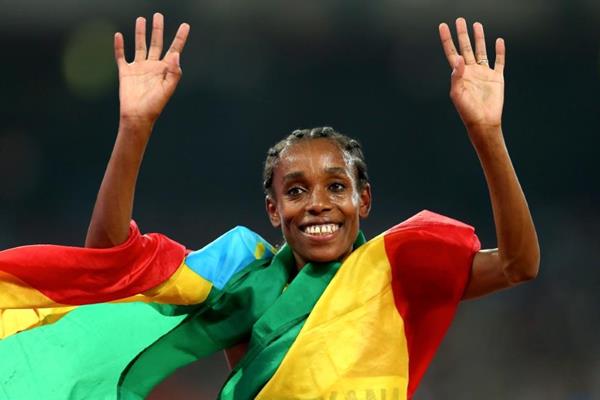
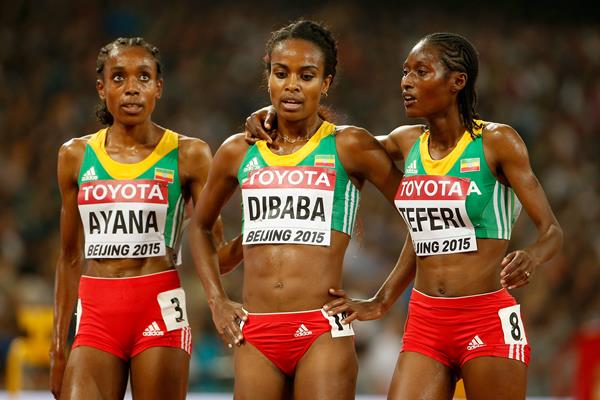
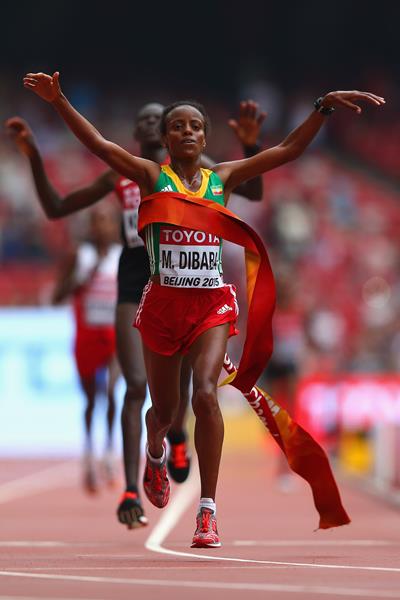





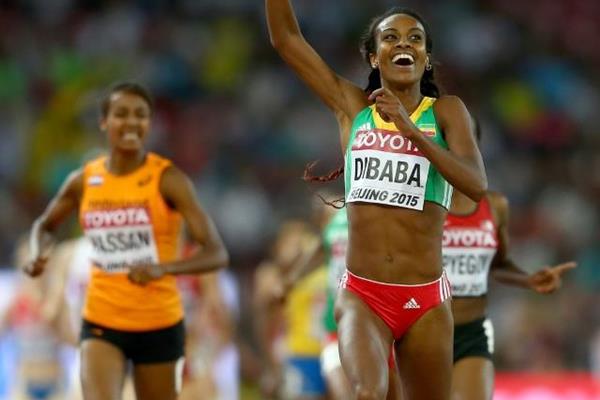
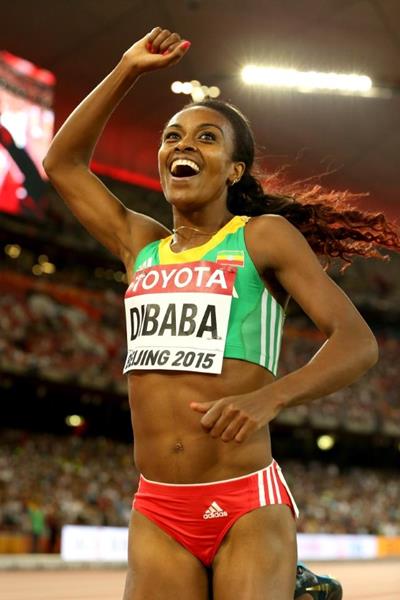 It took little more than four minutes for Genzebe Dibaba to run the full 1500m distance, but the damage was all done in the last two.
It took little more than four minutes for Genzebe Dibaba to run the full 1500m distance, but the damage was all done in the last two.